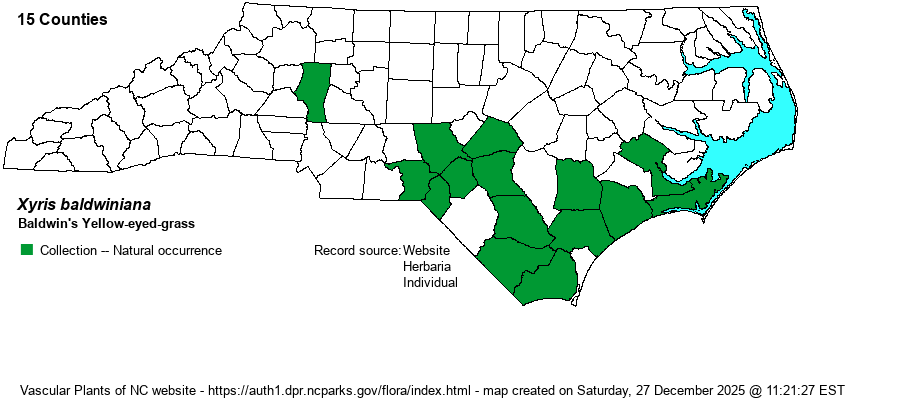| Author | J.A. Schultes | |
| Distribution | Southern Coastal Plain and Sandhills; disjunct to the Piedmont in a seepage bog in Iredell County.
Coastal Plain, NC to northern FL, eastern TX, and southern AR. Also southern Mex. and C.A. | |
| Abundance | Uncommon; absent from much apparently suitable habitat. Extremely rare in the Piedmont, if not now historical. | |
| Habitat | Wet, sandy or peaty, acidic soils of Longleaf Pine-Wirgrass savannas and flatwoods, blackwater streamheads and ecotones, pitcher-plant seeps and bogs. |
| Phenology | Flowering and fruiting June-July (perhaps earlier and later). | |
| Identification | Baldwin's Yellow-eyed-grass is relatively easy to identify, due to the numerous, very narrow leaves that vary from round in cross-section to somewhat flattened. Scapes (stems) are slender and usually less than a foot tall, often sinuous, and with a small terminal head. Curtiss's Yellow-eyed-grass (X. curtissii) is about the same size, but its leaves are flattened and wider and form an obvious fan at ground level. Beware of plants with flattened leaves! These have in the past been misidentified as X. elliottii, which has yet to be verified for NC. | |
| Taxonomic Comments | Members of Xyris are easy to identify to genus, but can be a challenge to identify species. Careful observation of a few features with a hand-lens is usually sufficient. Close attention must be paid to the flowering head, which is composed of overlapping brown scales. Immediately behind each scale are two brown "lateral sepals"; the margins of these may be feathery or irregularly lacerate (cut into narrow segments) or finely cut into short, comb-like prickles. Lateral sepals may be hidden or a bit longer than each scale. The flowers themselves are usually of little diagnostic value, other than time of flowering -- morning vs. afternoon. Seed size and ornamentation can also be useful characters, but require a dissecting scope to see well. Note also whether leaves and scapes (stems) are twisted and the color of the basal portion. All species have 2-ranked leaves, but in some species the leaves are arranged in a broad, fan-like shape. Finally, note the leaf and stem surface texture -- whether smooth of with little pale bumps. See Godfrey & Wooten (1979) for detailed descriptions and drawings. | |
| Other Common Name(s) | None | |
| State Rank | S2 [S3] | |
| Global Rank | G5 | |
| State Status | | |
| US Status | | |
| USACE-agcp | OBL link |
| USACE-emp | OBL link |

